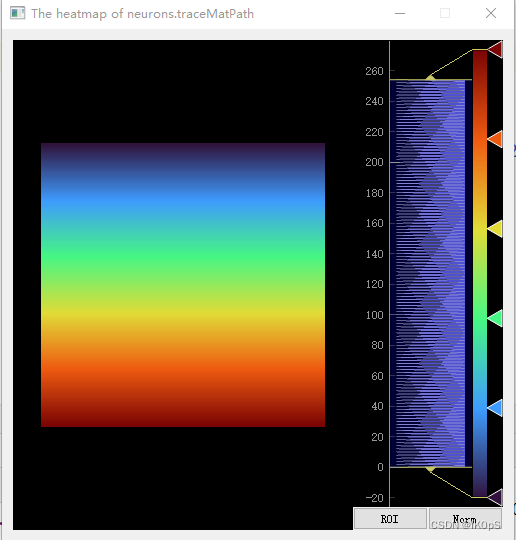-
pyqtgraph只使用image view进行热图的可视化展示 (一个脚本)创建一个窗口
pyqtgraph只使用image view进行热图的可视化展示
""" import scipy.io as scio import numpy as np import pyqtgraph as pg from PyQt5 import QtCore, QtGui from PyQt5.QtWidgets import * from PyQt5 import uic if __name__ == '__main__': # import sys app = QApplication(sys.argv) print("对参与同步簇点火的神经元进行Sorting") data = np.array([[i for i in range(255)] for _ in range(255)]) # 可视化 winHeatmap = uic.loadUi(r'../GUI/Empty.ui') winHeatmap.setFixedSize(2000, 400) ivHeatmap = pg.ImageView() winHeatmap.verticalLayout_2.addWidget(ivHeatmap) ivHeatmap.setImage(data) colors = [(48, 18, 59), (62, 155, 254), (70, 247, 131), (225, 220, 55), (239, 90, 17), (122, 4, 3), ] cmap = pg.ColorMap(pos=np.linspace(0.0, 1.0, 6), color=colors) ivHeatmap.setColorMap(cmap) winHeatmap.setWindowTitle("The heatmap of neurons.\t{}".format("traceMatPath")) winHeatmap.show() if (sys.flags.interactive != 1) or not hasattr(QtCore, 'PYQT_VERSION'): QtGui.QApplication.instance().exec_()
---------
和人家提供的exapmle类似
# -*- coding: utf-8 -*- """ This example demonstrates the use of ImageView, which is a high-level widget for displaying and analyzing 2D and 3D data. ImageView provides: 1. A zoomable region (ViewBox) for displaying the image 2. A combination histogram and gradient editor (HistogramLUTItem) for controlling the visual appearance of the image 3. A timeline for selecting the currently displayed frame (for 3D data only). 4. Tools for very basic analysis of image data (see ROI and Norm buttons) """ ## Add path to library (just for examples; you do not need this) import initExample import numpy as np from pyqtgraph.Qt import QtCore, QtGui import pyqtgraph as pg # Interpret image data as row-major instead of col-major pg.setConfigOptions(imageAxisOrder='row-major') app = QtGui.QApplication([]) ## Create window with ImageView widget win = QtGui.QMainWindow() win.resize(800,800) imv = pg.ImageView() win.setCentralWidget(imv) win.show() win.setWindowTitle('pyqtgraph example: ImageView') ## Create random 3D data set with noisy signals img = pg.gaussianFilter(np.random.normal(size=(200, 200)), (5, 5)) * 20 + 100 img = img[np.newaxis,:,:] decay = np.exp(-np.linspace(0,0.3,100))[:,np.newaxis,np.newaxis] data = np.random.normal(size=(100, 200, 200)) data += img * decay data += 2 ## Add time-varying signal sig = np.zeros(data.shape[0]) sig[30:] += np.exp(-np.linspace(1,10, 70)) sig[40:] += np.exp(-np.linspace(1,10, 60)) sig[70:] += np.exp(-np.linspace(1,10, 30)) sig = sig[:,np.newaxis,np.newaxis] * 3 data[:,50:60,30:40] += sig ## Display the data and assign each frame a time value from 1.0 to 3.0 imv.setImage(data, xvals=np.linspace(1., 3., data.shape[0])) ## Set a custom color map colors = [ (0, 0, 0), (45, 5, 61), (84, 42, 55), (150, 87, 60), (208, 171, 141), (255, 255, 255) ] cmap = pg.ColorMap(pos=np.linspace(0.0, 1.0, 6), color=colors) imv.setColorMap(cmap) ## Start Qt event loop unless running in interactive mode. if __name__ == '__main__': import sys if (sys.flags.interactive != 1) or not hasattr(QtCore, 'PYQT_VERSION'): QtGui.QApplication.instance().exec_() -
相关阅读:
sqli-labs/Less-46
pandas学习资源
Ansible 自动化运维企业实战 (二)
【填坑】乐鑫ESP32C3 Bootloader开发(上)
Feign实现文件上传下载
【【STM32-29正点原子版本串口发送传输实验】
【OS】I/O多路复用的一点理解
[解题报告] CSDN竞赛第六期
Android自定义View——实现字母导航栏
HTML5期末考核大作业 基于HTML+CSS+JavaScript沪上美食(9页)
- 原文地址:https://blog.csdn.net/Hodors/article/details/126451150